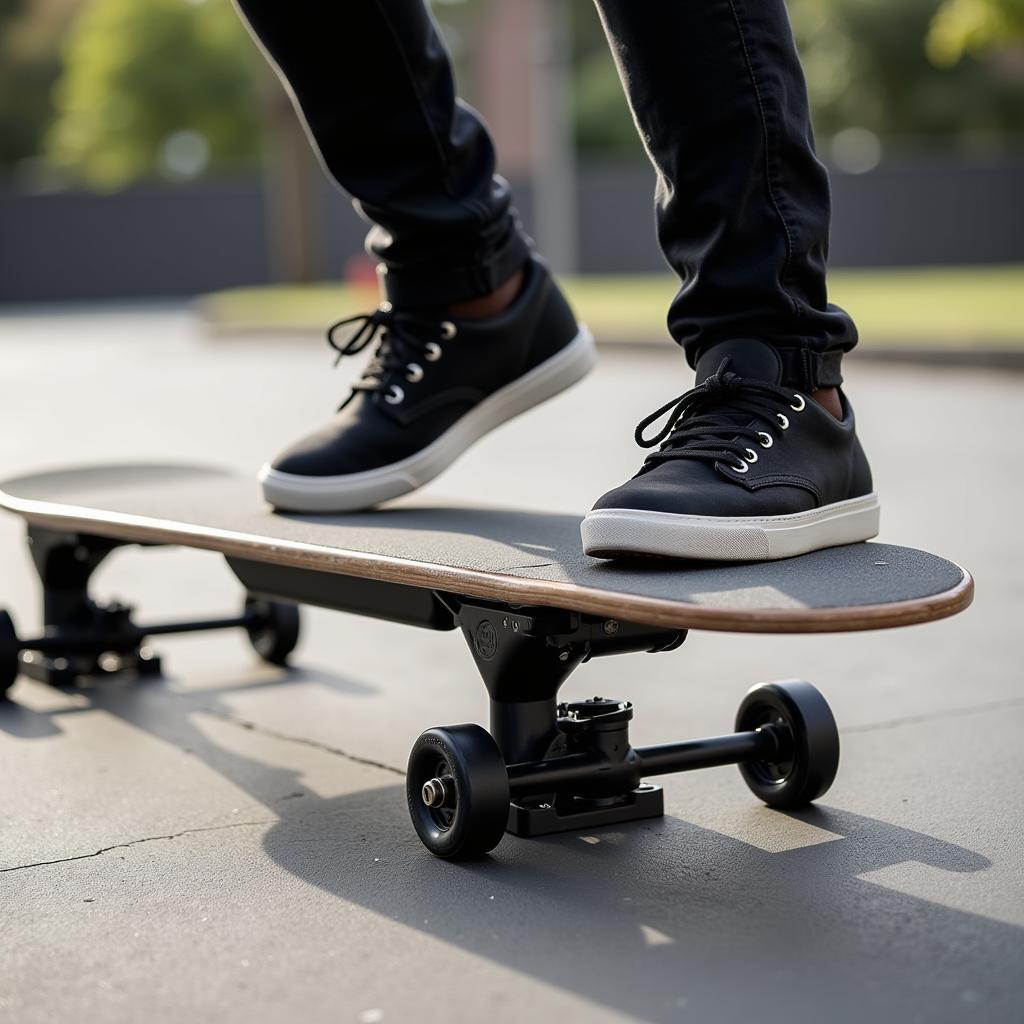Master Your Grind with the Right Skate Rail Flat Bar
October 13, 2024A Skate Rail Flat Bar might seem like a simple piece of metal, but it’s the foundation for countless grinds and tricks in the world of skateboarding. Choosing the right one can be the difference between landing your next move and taking a tumble. Whether you’re a seasoned skater looking to upgrade your setup or a beginner searching for the perfect first rail, this guide will equip you with the knowledge you need to conquer any obstacle.
What is a Skate Rail Flat Bar?
 Skateboarder grinding on a flat bar
Skateboarder grinding on a flat bar
Simply put, a skate rail flat bar is a long, flat piece of metal, typically made of steel or aluminum, designed for skateboarding. It’s called “flat” to differentiate it from round rails or other shapes. You’ll often find them in skateparks, but many skaters, especially beginners, prefer to have one at home for practice.
Why Choose a Flat Bar Over Other Rail Types?
Flat bars are the ideal starting point for anyone new to grinding. Their flat surface provides a larger area for your grinds, making them more forgiving than round rails or other complex shapes.
Here’s why a flat bar might be right for you:
- Beginner-friendly: The flat, stable surface makes it easier to find your balance and master basic grinds.
- Versatile: You can practice a variety of grinds on a flat bar, from 50-50s to boardslides and lipslides.
- Affordable: Flat bars are generally less expensive than other rail types, making them a great option for budget-conscious skaters.
Key Factors to Consider When Choosing a Skate Rail Flat Bar
 Various types and sizes of skate rail flat bars
Various types and sizes of skate rail flat bars
Before you grab the first flat bar you see, there are a few crucial factors to keep in mind:
1. Length: Find Your Sweet Spot
The length of your flat bar directly impacts the difficulty and style of tricks you can perform.
- Shorter bars (4-6 feet): Perfect for beginners, practicing ollies over the rail, or mastering basic grinds in a confined space.
- Medium bars (8-10 feet): Offer more space to experiment with speed and different grind variations.
- Longer bars (12+ feet): For experienced skaters looking to challenge themselves with longer grinds and more complex lines.
2. Material: Durability is Key
Most skate rail flat bars are made from steel or aluminum.
- Steel: Incredibly durable and can withstand heavy use, but can be heavier and prone to rust if not properly maintained.
- Aluminum: Lighter and rust-resistant, making them easier to move around, but might not be as durable as steel for aggressive grinding.
3. Width: Find Your Grinding Groove
The width of the flat bar determines the surface area you have for your grinds.
- Narrow bars (1-1.5 inches): Require more precision and balance, making them ideal for technical grinds.
- Wider bars (2+ inches): Offer more stability and are suitable for beginners or skaters who prefer a more forgiving surface.
Setting Up Your Skate Rail Flat Bar: Safety First
 A safe and secure setup for a skate rail flat bar
A safe and secure setup for a skate rail flat bar
Once you’ve chosen your ideal flat bar, it’s crucial to set it up correctly to prevent accidents:
- Stable base: Ensure your flat bar is securely mounted on a solid, level surface. Use concrete blocks, wooden beams, or a dedicated rail stand for maximum stability.
- Clear the area: Remove any obstacles, debris, or tripping hazards around the rail.
- Start slow: Begin by practicing ollies over the rail before attempting grinds.
- Gear up: Always wear appropriate safety gear, including a helmet, knee pads, and elbow pads.
Mastering the Basics: Essential Grinds for Flat Bars
Ready to start grinding? Here are a few fundamental grinds to master on your flat bar:
- 50-50 Grind: The most basic grind where you slide along the rail with both trucks grinding.
- Boardslide: Approach the rail with your board perpendicular, ollie up, and slide with the center of your board along the rail.
- Lipslide: Similar to a boardslide, but you approach the rail with your back foot facing it.
Conclusion: Elevate Your Skating with a Skate Rail Flat Bar
Choosing the right skate rail flat bar is an investment in your skateboarding journey. Whether you’re a beginner or a seasoned pro, a flat bar offers endless opportunities to hone your skills, master new tricks, and take your skating to the next level. Remember to prioritize safety, start slow, and most importantly, have fun!